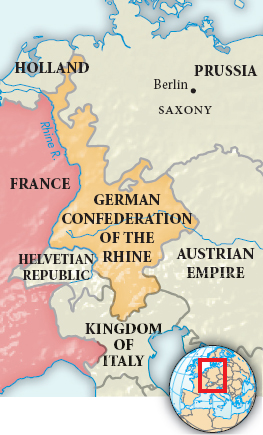Napoleon’s Expansion in Europe

Napoleon was above all a great military man. After coming to power in 1799, he sent peace feelers to Austria and Great Britain, the two remaining members of the Second Coalition that had been formed against France in 1798. When they rejected his overtures, Napoleon’s armies decisively defeated the Austrians. In the Treaty of Lunéville (1801), Austria accepted the loss of almost all its Italian possessions, and German territory on the west bank of the Rhine was incorporated into France. The British agreed to the Treaty of Amiens in 1802, allowing France to control the former Dutch Republic, the Austrian Netherlands, the west bank of the Rhine, and most of the Italian peninsula.
In 1802, Napoleon was secure but driven to expand his power. Aggressively redrawing the map of Germany to weaken Austria and encourage the secondary states of southwestern Germany to side with France, Napoleon tried to restrict British trade with all of Europe. He then plotted to attack Great Britain, but his Mediterranean fleet was destroyed by Lord Nelson at the Battle of Trafalgar on October 21, 1805. Invasion of England was henceforth impossible. Renewed fighting had its advantages, however, for the first consul used the wartime atmosphere to have himself proclaimed emperor in late 1804.
Austria, Russia, and Sweden joined with Britain to form the Third Coalition against France shortly before the Battle of Trafalgar. Actions such as Napoleon’s assumption of the Italian crown had convinced both Alexander I of Russia and Francis II of Austria that Napoleon was a threat to the European balance of power. Yet they were no match for Napoleon, who scored a brilliant victory over them at the Battle of Austerlitz in December 1805. Alexander I decided to pull back, and Austria accepted large territorial losses in return for peace as the Third Coalition collapsed.
Napoleon then proceeded to reorganize the German states. In 1806, he abolished many of the tiny German states as well as the ancient Holy Roman Empire. He established by decree the German Confederation of the Rhine, a union of fifteen German states minus Austria, Prussia, and Saxony. Naming himself “protector” of the confederation, Napoleon firmly controlled western Germany.
Napoleon’s intervention in German affairs alarmed the Prussians, who mobilized their armies after more than a decade of peace with France. Napoleon attacked and won two more brilliant victories in October 1806 at Jena and Auerstädt. The war with Prussia, now joined by Russia, continued into the following spring. After Napoleon’s larger armies won another victory, Alexander I of Russia was ready to negotiate the peace. In the subsequent treaties of Tilsit in 1807, Prussia lost half of its population, while Russia accepted Napoleon’s reorganization of western and central Europe and promised to enforce Napoleon’s economic blockade against British goods.
| November 1799 | Napoleon overthrows the Directory |
| December 1799 | Napoleon’s new constitution approved |
| 1800 | Foundation of the Bank of France |
| 1801 | France defeats Austria and acquires Italian and German territories in the Treaty of Lunéville; Napoleon signs papal Concordat |
| 1802 | Treaty of Amiens |
| March 1804 | Napoleonic Code |
| December 1804 | Napoleon crowned emperor |
| October 1805 | Britain defeats the French fleet at the Battle of Trafalgar |
| December 1805 | Napoleon defeats Austria and Russia at the Battle of Austerlitz |
| 1807 | Napoleon redraws map of Europe in the treaties of Tilsit |
| 1808 | Spanish revolt against French occupation |
| 1810 | Height of the Grand Empire |
| June 1812 | Napoleon invades Russia |
| Fall– |
Napoleon makes a disastrous retreat from Russia |
| March 1814 | Russia, Prussia, Austria, and Britain sign the Treaty of Chaumont, pledging alliance to defeat Napoleon |
| April 1814 | Napoleon abdicates and is exiled to Elba; Louis XVIII restored to constitutional monarchy |
| February– |
Napoleon escapes from Elba but is defeated at the Battle of Waterloo; Louis XVIII restored to throne for second time |